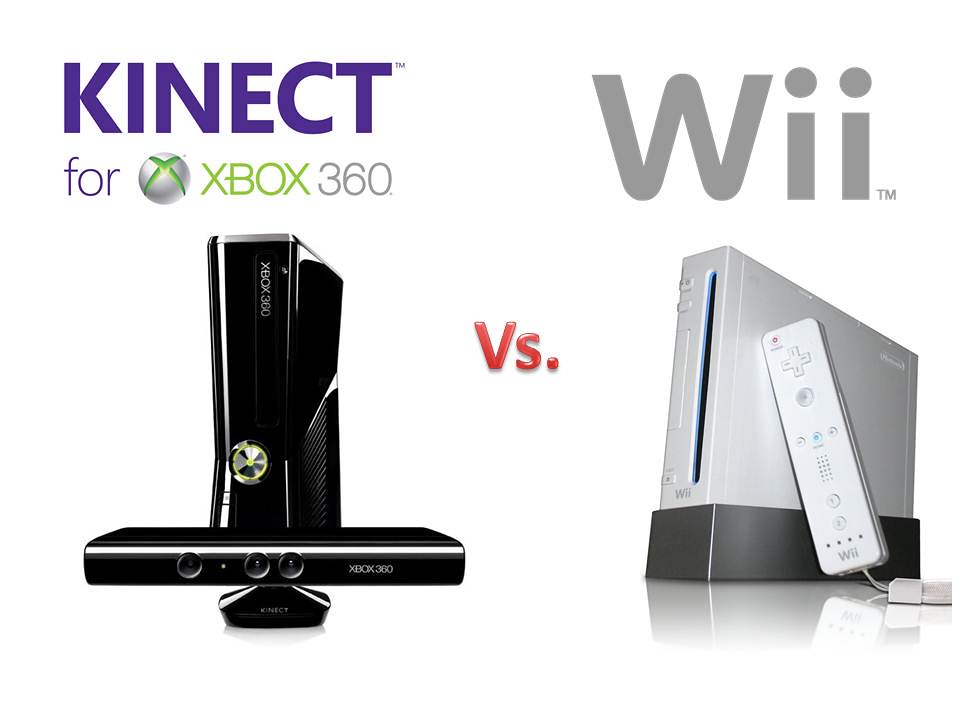WebPT bloggers Lindsay Bayuk, Charlotte Bohnett, and Erica Cohen co-wrote today’s post.
Video games are no longer the exclusive pastime of teenage boys. Now, interactive and health-centric videogame software allows people of all ages to stay fit, improve range of motion, and battle out a seriously competitive game of Wii Tennis—all from the comfort of their living room.
Video games are no longer the exclusive pastime of teenage boys. Now, interactive and health-centric videogame software allows people of all ages to stay fit, improve range of motion, and battle out a seriously competitive game of Wii Tennis—all from the comfort of their living room.
Two of the most popular movement-sensing consoles are the Nintendo Wii and Microsoft’s Xbox 360 Kinect. While both boast all sorts of games, from fly fishing to dancing, their mechanism for motion detection is slightly different. With Wii, the console detects user movements via a wireless remote and incorporates them into the action occurring within the game, typically through a character or animated avatar. With Xbox 360 Kinect, though, the user is the controller. The console detects user movements and displays them on the screen as part of the game. There’s no remote, and Kinect games typically show a more realistic human avatar as the system mirrors the user.

User as controller on Kinect Wireless controller for WiiImage from http://www.vooks.net/images/kinect_vs_wii.jpg
More than 96 million Wii systems have shipped since its 2006 inception and over 18 million Kinect systems have shipped since its debut in 2010. Obviously, these systems are popular, and everyone from nursing home residents to the Queen of England is playing. So, how can you incorporate these new-age video consoles into your treatment plans?
Recently, Johns Hopkins researchers implemented the Wii’s Play and Fit video games into a 22-patient study. Researchers incorporated video game activities such as bowling and boxing into 42 physical therapy sessions for their patients. While they concluded they needed additional research, the researchers found patients enjoyed the challenge the videos games presented and welcomed the change in their physical routines.
The enjoyment and challenge has led many clinics to incorporate motion gaming into their practice. In this ABC News segment, Broward General shows how they use WiiHab to help elderly patients with mobility and hand-eye coordination.
The enjoyment and challenge has led many clinics to incorporate motion gaming into their practice. In this ABC News segment, Broward General shows how they use WiiHab to help elderly patients with mobility and hand-eye coordination.
"In the Wii-Hab system, because it's kind of a game format, it does create this kind of inner competitiveness. Even though you may be boxing or playing tennis against some figure on the screen, it's amazing how many of our patients want to beat their opponent," said James Osborn, who oversees rehabilitation services at Herrin Hospital in southern Illinois. Herrin Hospital, which is about 100 miles southeast of St. Louis, implemented a Wii system in 2007.
And, there are many Wiihab success stories. Judith Deutsch, PT, PhD implemented Wii-Hab in conjunction with traditional physical therapy. She was able to improve the visual-perceptual processing, postural control, and functional mobility of a 13-year old boy suffering from spastic diplegic cerebral palsy. Additionally, a case study in the Games for Health Journal found that using the Wii in conjunction with traditional rehabilitation practices improved user engagement, balance, and mobility improved for burn patients.
At Walter Reed Army Medical Center, Wii therapy is well suited for patients injured in combat in Iraq. Many are between 19 and 25 years old and love playing video games. Lt. Col. Stephanie Daugherty, Walter Reed's chief of occupational therapy says, “They think it's for entertainment, but we know it's for therapy.”
In an article in The Minnesota Daily, Loren Terveen, associate professor of computer science and engineering at the Sister Kenny Rehabilitation Institute, concurs with Walter Reed: "Doing your physical therapy is pretty boring," he said. "If you can make it into an enjoyable activity where you're moving physically and going through motions that are helping you recover, and as a part of that you're playing games that are fun, it's just a great, creative use of the technology."
Erica Stern, associate professor and director of graduate studies in the program of occupational therapy, said the Wii's reasonable price allows patients to use the system to continue rehabilitation at home: "The biggest asset that the Wii offers to me is that it's low-priced enough that people can develop home programs off of it," she said. "Once the patient can be independent in its use, why not?"
Interested in learning more about the benefits of using the Wii at your practice? Check out this list from Comprehensive Orthopedic Physical Therapy.
While the Kinect debuted later than the Wii, therapists are now commonly employing this system in their practice as well. In fact,IndustryGamers recently reported that “developer Red Hill Studios has created, in partnership with the UCSF School of Nursing, a custom suite of Kinect-based physical therapy games...specifically designed to help people with Parkinson's.”
Additionally, in a 2011 article on Engineering Sport, Simon Choppin discussed the use of the Xbox 360 Kinect in a physical therapy setting, specifically how therapists can use the system for simple motion analysis. Comparing the Kinect to Dartfish, Choppin found that while Kinect doesn’t currently possess the same level of accuracy as Dartfish, therapists can use the Kinect console for exercises. Additionally, Choppin surmises that eventually Microsoft will improve the Kinect to the point where it can used for analytical purposes.
But game motion therapy doesn’t stop with Nintendo and Xbox. Student developers are designing preliminary video game systems for the physical therapy industry. For example, Rice University students created Equilibrium, which was commissioned by the Shriner’s Hospital as a way to get kids excited about improving walking gait and balance. Equilibrium uses the Wii Balance Board, some Wii software applications, and custom designed balance bars in a monster shooting game that increases in difficulty as patients progress in therapy.
As with any exercise program, there’s opportunity for injury. Proper form and moderation are important to avoid what’s recently been coined “Wiiitis,” (pronounced wee-eye-tis). Symptoms include muscle soreness, aches, and any pain associated with video game overuse. Hence, many therapists use the Wii in conjunction with other therapy practices to enhance treatment (both in terms of enjoyment and rehabilitation) rather than rely solely on the new technology.
Are you implementing motion gaming in your therapy practice? We’d love to hear what works for your plan of care and your patients.
And, there are many Wiihab success stories. Judith Deutsch, PT, PhD implemented Wii-Hab in conjunction with traditional physical therapy. She was able to improve the visual-perceptual processing, postural control, and functional mobility of a 13-year old boy suffering from spastic diplegic cerebral palsy. Additionally, a case study in the Games for Health Journal found that using the Wii in conjunction with traditional rehabilitation practices improved user engagement, balance, and mobility improved for burn patients.
At Walter Reed Army Medical Center, Wii therapy is well suited for patients injured in combat in Iraq. Many are between 19 and 25 years old and love playing video games. Lt. Col. Stephanie Daugherty, Walter Reed's chief of occupational therapy says, “They think it's for entertainment, but we know it's for therapy.”
In an article in The Minnesota Daily, Loren Terveen, associate professor of computer science and engineering at the Sister Kenny Rehabilitation Institute, concurs with Walter Reed: "Doing your physical therapy is pretty boring," he said. "If you can make it into an enjoyable activity where you're moving physically and going through motions that are helping you recover, and as a part of that you're playing games that are fun, it's just a great, creative use of the technology."
Erica Stern, associate professor and director of graduate studies in the program of occupational therapy, said the Wii's reasonable price allows patients to use the system to continue rehabilitation at home: "The biggest asset that the Wii offers to me is that it's low-priced enough that people can develop home programs off of it," she said. "Once the patient can be independent in its use, why not?"
Interested in learning more about the benefits of using the Wii at your practice? Check out this list from Comprehensive Orthopedic Physical Therapy.
While the Kinect debuted later than the Wii, therapists are now commonly employing this system in their practice as well. In fact,IndustryGamers recently reported that “developer Red Hill Studios has created, in partnership with the UCSF School of Nursing, a custom suite of Kinect-based physical therapy games...specifically designed to help people with Parkinson's.”
Additionally, in a 2011 article on Engineering Sport, Simon Choppin discussed the use of the Xbox 360 Kinect in a physical therapy setting, specifically how therapists can use the system for simple motion analysis. Comparing the Kinect to Dartfish, Choppin found that while Kinect doesn’t currently possess the same level of accuracy as Dartfish, therapists can use the Kinect console for exercises. Additionally, Choppin surmises that eventually Microsoft will improve the Kinect to the point where it can used for analytical purposes.
But game motion therapy doesn’t stop with Nintendo and Xbox. Student developers are designing preliminary video game systems for the physical therapy industry. For example, Rice University students created Equilibrium, which was commissioned by the Shriner’s Hospital as a way to get kids excited about improving walking gait and balance. Equilibrium uses the Wii Balance Board, some Wii software applications, and custom designed balance bars in a monster shooting game that increases in difficulty as patients progress in therapy.
As with any exercise program, there’s opportunity for injury. Proper form and moderation are important to avoid what’s recently been coined “Wiiitis,” (pronounced wee-eye-tis). Symptoms include muscle soreness, aches, and any pain associated with video game overuse. Hence, many therapists use the Wii in conjunction with other therapy practices to enhance treatment (both in terms of enjoyment and rehabilitation) rather than rely solely on the new technology.
Are you implementing motion gaming in your therapy practice? We’d love to hear what works for your plan of care and your patients.

Sem comentários:
Enviar um comentário
Gostou do meu Blog? Envie a sua opinião para lmbgouveia@gmail.com